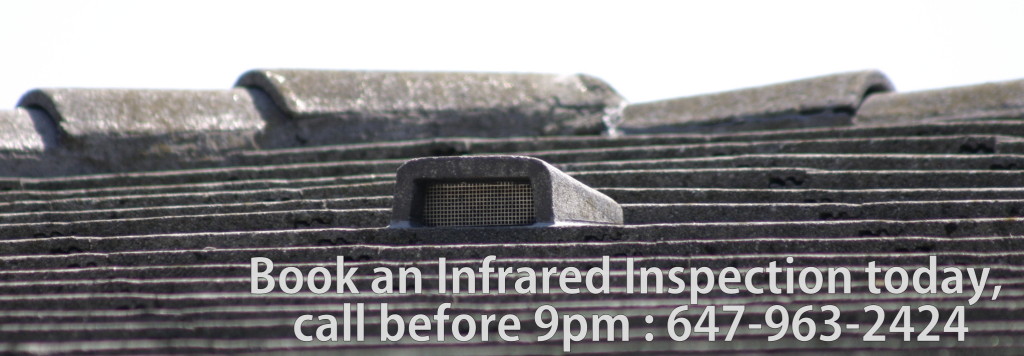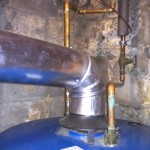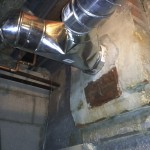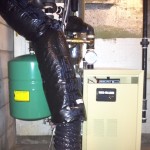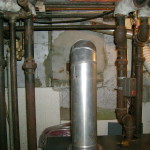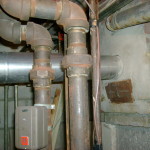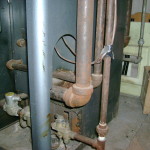Heating
posts displayed by category
Back drafts in the home and how they can kill you.
Oct 22 2013Back drafts are caused when the house is under negative pressure. A good sign the house is under negative pressure is when you open a door and it closes by itself behind you or if you open a window and a breeze blows in. Depending on the appliances you have operating in the house, back draft conditions may exist and occupants may be subject to carbon monoxide poisoning. CO is produced when you have incomplete combustion, when the fuel being burned does not have enough combustion air to completely burn the fuel. A common situation found during a home inspection is a furnace room being sealed up with dry wall without sufficient supply air. This situation is fine if the appliances in the the room is direct vented. That means the intake supply air and exhaust are piped directly to the exterior through the side walls. The appliances of concern include hot water tank or mid efficiency furnace which uses natural draft to vent the combustion exhaust, Natural draft appliances require the house to be under positive pressure to work adequately.
During a home inspection, experienced home inspectors look for the above conditions and note the potential hazard. In addition, some subtle situation the home owner may not be aware of include the dryer acting as an exhaust, a kitchen exhaust fan, a attic or whole house fan exhausting directly to the exterior, a chimney flue left open, which all can contribute to the house being under negative pressure preventing natural draft appliances from working properly.

Gaps in the duct work can decrease efficiency of system by about 15%. This is a typical furnace upgrade from mid efficiency natural draft to high efficiency 2 pipe direct vent. The upgrade resulted in modifications that needed tape and patches to seal gaps.
Another subtle condition are the leaks in the ducts from the boot of the furnace to the jumper in the furnace room. All the leaks add up to the equivalent of having return vent near the blower motor. First, the return air should come from either the first floor or second floor but not in the basement as a rule of thumb. There is typically enough leaks in the duct works around the furnace to decrease the efficiency of the system about approximately 15%. The blower motor is strong enough to create a negative pressure environment in the furnace room and thus create back drafts in the natural draft vents. With a return vent close by or at the blower motor, a negative pressure environment is also created.
I have the old furnace and old boiler systems. How can I tell if they are still safe to use this winter?
Oct 21 2013By the term ‘old’ we are referring to the natural draft appliances that burn natural gas or propane. These include furnaces and boilers that recently, TSSA has determined may result in carbon monoxide (CO) safety hazard in the home and may cause personal injury and even result in death.
The safe use of fuels used to heat our homes in Ontario falls under the Technical Standards and Safety Act, 2000. The Technical Standards and Safety Authority (TSSA) is designated by Ontario’s Ministry of Consumer Services to administer and enforce this Act.
CO is a colorless, odorless and tasteless gas produced when fuels such as natural gas and propane are incompletely burned. Common causes include poor maintenance of the appliance leading to incomplete combustion of the fuel and depressurization of the house causing back draft conditions in the house. The depressurization of the home is caused by other exhaust systems that prevent the natural draft to work properly. Other exhaust systems include dryer exhaust, kitchen or bathroom exhaust and wood fire place. Also, the upgrades to more efficient windows and doors limit the outside air infiltration into the home creating a ‘tighter’ environment.
The symptoms of CO poisoning include vomiting and nausea, burning eyes and dizziness, difficulty breathing, confusion and victims may also become unconscious. If CO is undetected in the home, occupants have been found dead in their sleep.
So how can you tell if the appliances are safe to use? Get them checked and maintained on an annual basis by a licensed gas technician. They will perform a CO safety check during the maintenance visit. Install CO detector in the house. The ideal location of it is not in the furnace room or anywhere near it. You want it working ideally on the second floor hall way so that there is early warning when CO is detected instead of waiting of it to travel from one room to the next if you installed it in one of the bedrooms.
For more information visit www.tssa.org
